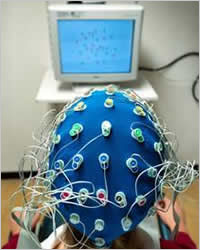
 An EEG (or “brain wave” test) looks at electrical activity in the brain and is sometimes able to detect abnormalities typical of epilepsy. Recordings are made with electrodes placed at a number of locations on the scalp and changes in the electrical potential of cells in the brain are recorded.
An EEG (or “brain wave” test) looks at electrical activity in the brain and is sometimes able to detect abnormalities typical of epilepsy. Recordings are made with electrodes placed at a number of locations on the scalp and changes in the electrical potential of cells in the brain are recorded.
An EEG is useful in supporting a diagnosis of epilepsy and is particularly helpful when trying to identify the region of the brain that the seizure originated. However, some patients with epilepsy will have a normal EEG and people without epilepsy may have an abnormal EEG; so it is important to remember that this method of investigation cannot be used as a straightforward test for epilepsy.
Generally an EEG will last for approximately 20-30 minutes while the patient is resting but awake. The patient may be exposed to a number of routine procedures that can increase the chances of detecting abnormalities; the two most commonly used are flashing lights and being asked to hyperventilate.
If further investigation is required, an EEG may be conducted when the individual has been sleep deprived. In this instance, the patient will be asked to not sleep during the night before the test. In some cases, a person’s brain waves may be recorded over a longer period of time.


Other Methods of Investigation


